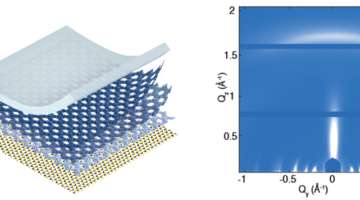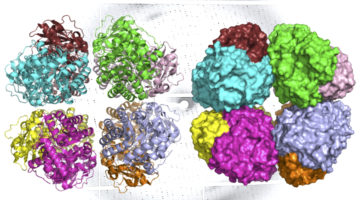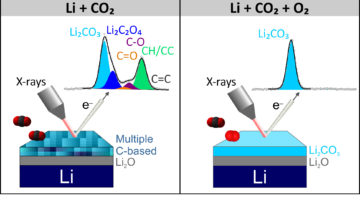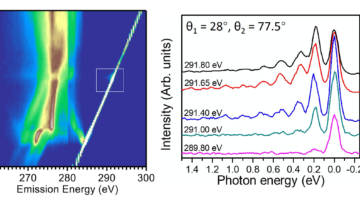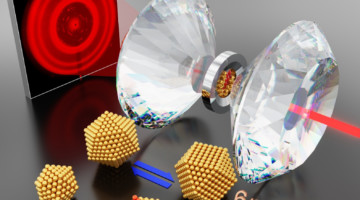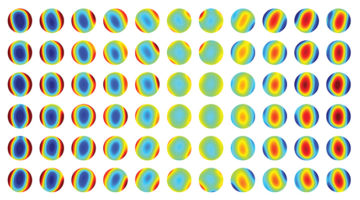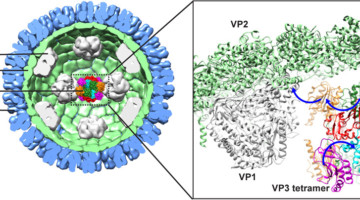Researchers fabricated an electronically coupled heterostructure from a novel semiconducting 2D polymer and a 2D transition metal dichalcogenide. Dramatic optical and electronic changes emerged as polymer thickness decreased, underscoring the potential for the discovery of emergent phenomena in studies of hybrid heterostructures. Read more »
Science Briefs
Newly Discovered Photosynthesis Enzyme Yields Evolutionary Clues
Scientists have discovered a primitive form of rubisco, a photosynthesis enzyme that has helped shape life on Earth. Detailed information about its structure, determined using complementary techniques at the ALS, will help scientists understand how carbon-fixing organisms oxygenated the atmosphere and how modern plants evolved. Read more »
New Insights into Lithium-Metal Surface Reactions for Next-Generation Batteries
In this work, researchers studied how CO2 gas modifies the chemical composition of lithium-metal surfaces. A better understanding of the interactions between lithium and surrounding gases will help design stabilization strategies and move from lithium-ion technology to high-energy-density technologies based on lithium metal. Read more »
Detecting Phonon Overtones in Correlated Materials
Resonant inelastic x-ray scattering (RIXS) has recently been shown to be a promising technique for studying electron–phonon coupling in correlated materials. When a photoexcited electron interacts with phonons during decay, it shows up in the RIXS spectra as clear phonon overtones: higher-order excitations that appear as ripples in intensity. Read more »
Stress-Induced Structural Transformations in Gold Nanocrystals
Metallic nanocrystals are widely used in catalysis, electronics, photonics, and sensing applications, but our understanding of their stability under operational stresses is limited. These studies of gold nanocrystals at high pressures found that large-scale structural transformation is possible and must be considered at the nanoscale. Read more »
Understanding Electronic Structure in MXenes, One Atomic Layer at a Time
MXenes are 2D materials that can host a rich array of distinct chemical compositions that can be tuned for a broad range of applications, from energy storage to water purification. Site-specific x-ray absorption spectroscopy helped identify the unique roles of surface and subsurface transition-metal atoms in Ti-based MXenes. Read more »
Characterization of EUV Optics using Intrinsic Mask Roughness
Researchers developed an in situ computational technique for measuring aberrations in EUV optics, taking advantage of the surface roughness of photomasks used to transfer circuit patterns onto chips. The technique will prove increasingly valuable in the characterization of coherent light sources and beamline optical systems. Read more »
Missing Lysine Link Could Improve Plant-Based Nutrition
To engineer crops with higher levels of the important amino acid, lysine, researchers solved the structure of an enzyme that helps break down lysine in plants. A fuller understanding of the factors affecting lysine levels should aid in the successful development of stable high-lysine crops to combat malnutrition globally. Read more »
Small but Still Mighty: Ultrafine Grains Produce Ultrastrong Metals
Researchers used in situ high-pressure diffraction to resolve a debate about whether a metal’s strength increases or decreases when its grain size decreases below a critical point. The results indicate that ultrastrong metals for future applications can indeed be achieved through grain-size refinement and grain-boundary engineering. Read more »
Rotavirus VP3 Is a Multifunctional Capping Machine
Rotavirus, a major cause of infantile gastroenteritis, is responsible for the deaths of about 200,000 children per year. Although vaccines are available, the virus still circulates, and a fuller understanding of the viral structures is needed. Here, scientists investigate the structure and function of the last unsolved rotavirus structural protein. Read more »
- « Previous Page
- 1
- …
- 8
- 9
- 10
- 11
- 12
- …
- 23
- Next Page »
